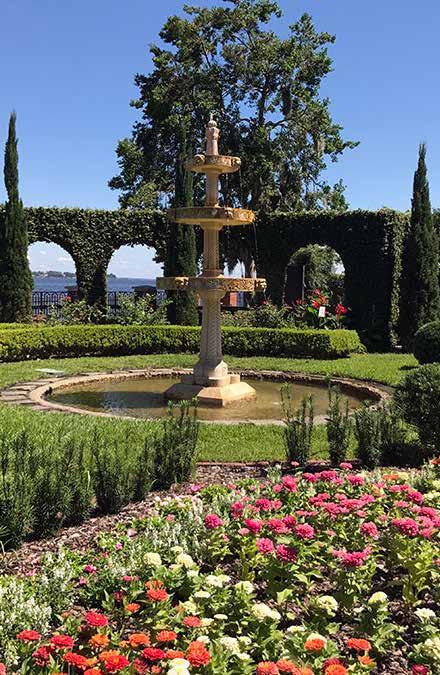
12 minute read
LOCATION OVERVIEW
from Portiva
AREA OVERVIEW JACKSONVILLE REGIONAL OVERVIEW
Jacksonville is the largest city in the state of Florida and the county seat of Duval County. The governments of the City of Jacksonville and Duval County consolidated in 1968, expanding Jacksonville’s city limits and making it the largest city in land area within the continental United States. Currently the city limits encompass 875 square miles. Consequently, most of Jacksonville’s metropolitan population lives within its city limits, and it is the most populous city proper in Florida and the thirteenth most populous in the United States. Jacksonville is located in the First Coast region of northeast Florida and is centered on the banks of the St. Johns River, about 25 miles south of the Florida/Georgia border and about 340 miles north of Miami.
Advertisement
Because of its size, Jacksonville is divided into six major sections with borders defined by a set of major roads and rivers that run through the city. Greater Arlington is east and south of the St. Johns River and north of Beach Boulevard. North Jacksonville is north of the St. Johns & Trout Rivers and east of US-1. Southeast Jacksonville, or Southside, is east of the St. Johns River and south of Beach Boulevard. West Jacksonville or Westside is west of the St. Johns River and south of Interstate 10. The Urban Core (Downtown Jacksonville) includes the banks of the narrowest part of the St. Johns River east of the Fuller Warren Bridge and extending roughly 4 miles north and east.
POPULATION
The Jacksonville MSA has historically been among some of the fastest growing metropolitan areas in the nation in terms of population growth. Jacksonville’s attractive quality of life, relative low cost of living, diversified economy and rapid job growth have helped drive in-migration to the region. According to Claritas, Inc., the Jacksonville MSA has an estimated 2017 population of 1.5 million residents. Jacksonville’s average annual population growth rate of 1.9% is greater than both the State of Florida and the national average. By 2022, Jacksonville’s population is forecasted to be approximately 1.6 million residents.
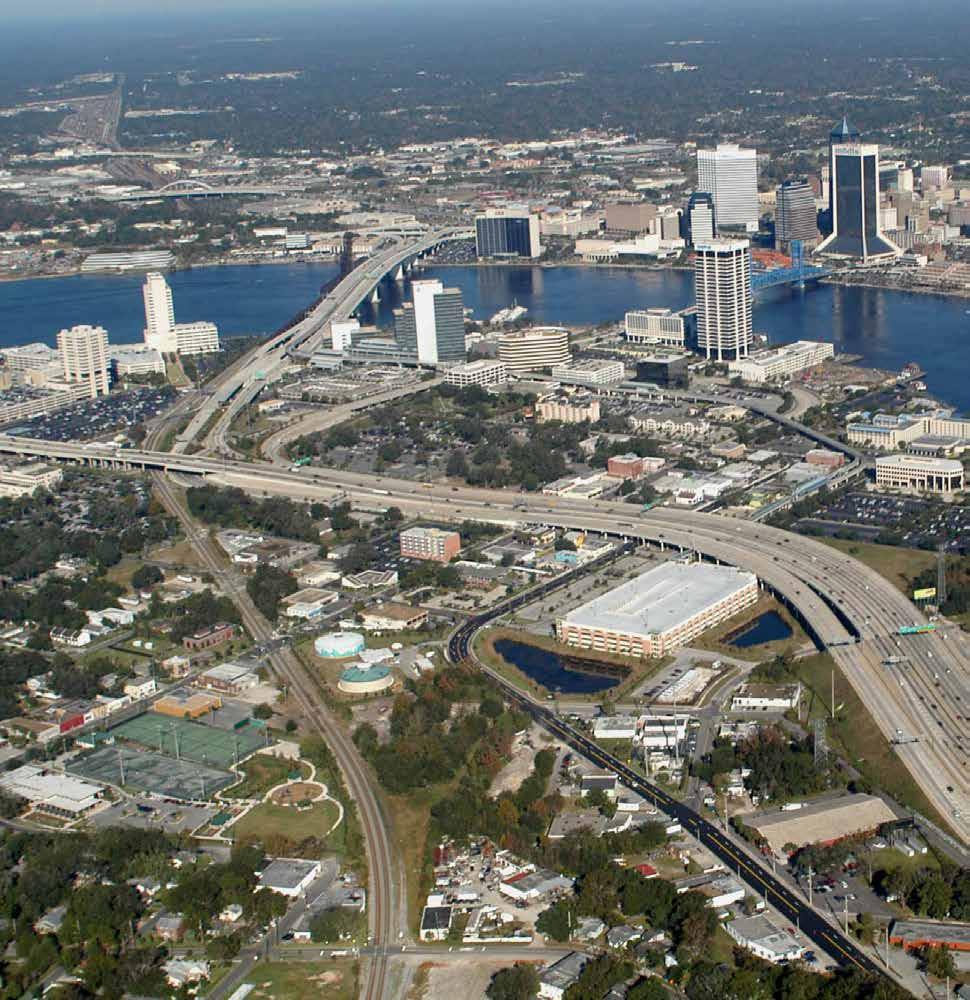
Downtown Jacksonville Aerial View POPULATION GROWTH HISTORY JAX PERCENT STATE OF YEAR MSA CHANGE FLORIDA
2023 Projection 1,624,722 6.9% 22,528,389 2018 Estimate 1,519,940 13.0% 21,107,181 2010 Census 1,345,596 19.8% 18,801,310 2000 Census 1,122,755 - 15,982,377
ANNUAL GROWTH 2000-2018 1.97%
Source: U.S. Census Bureau; Claritas, Inc.
COST OF LIVING COMPARISON
METROPOLITAN AREA
New York, NY San Francisco, CA Washington, DC Seattle, WA Chicago, IL Miami, FL Charleston, SC (U.S. Composite Average) Houston, TX Phoenix, AZ Atlanta, GA Charlotte, NC Denver, CO Jacksonville, FL St. Louis, MO
Source: ACCRA
PERCENT CHANGE
6.7%
UNITED STATES
337,947,861
12.3%
17.6%
1.78%
326,533,070
308,745,538
281,421,942
PERCENT CHANGE
3.5%
5.8%
9.7%
0.89%
INDEX 232.0 181.9 151.6 143.1 117.6 108.7 103.8 100.0 99.4 98.6 97.6 95.9 94.8 93.5 89.7
ECONOMY
Both the state of Florida and the Jacksonville MSA have experienced rapid economic growth over the last three decades, often leading the nation in job creation. Contributing to the success of the metropolitan area are a well-established and growing corporate presence, high quality of life, favorable taxes, an educational system committed to excellence, and a skilled and dedicated workforce.
As the adjacent table illustrates, Jacksonville’s average annual employment growth rate of 3% between 2011 and 2018 is considerably greater than the national average over the same time period. Jacksonville’s employment gain of 21,100 in 2017 was among the strongest in the nation. As a result, Forbes ranked Jacksonville as the fifth fastest growing city in the U.S. out of 25 featured MSAs.
Jacksonville’s location on the St. Johns River and the Atlantic Ocean proved advantageous in the growth of the city and its industry. Jacksonville has a sizable deepwater port, which helps make it a leading port in the U.S. for automobile imports, as well as the leading transportation and distribution hub in the state. However, the strength of the city’s economy lies in its broad diversification. The area’s economy is balanced among distribution, financial services, biomedical technology, consumer goods, information services, manufacturing, insurance and other industries.
Jacksonville is a rail, air, and highway focal point and a busy port of entry, with Jacksonville International Airport, ship repair yards and extensive freight-handling facilities. The Jacksonville Port Authority (JAXPORT) is a large component of the local economy. It is one of the largest commercial cargo ports on the Atlantic Coast consisting of three public terminals and one passenger cruise terminal. Approximately 130,000 jobs in Northeast Florida are related to port activity and the port has an economic impact of more than $27 billion.
Three major railroads - CSX, Norfolk Southern and Florida East Coast Railway - use Jacksonville as a railroad hub/interchange. Some of Jacksonville’s leading logistics employers are Southeastern Grocers, CSX Corporation, UPS, Crowley Maritime, Publix, Landstar and Wal-Mart.
JAX MSA EMPL. YEAR (000) CHANGE
2011 586.2 2012 594.6 1% 2013 608.0 2% 2014 624.1 3% 2015 646.2 4% 2016 668.6 3% 2017 689.7 3% 2018* 699.1 1%
ANNUAL GROWTH 3% STATE OF FLORIDA EMPL. (000) CHANGE
7,252 7,397 2% 7,581 2% 7,824 3% 8,107 4% 8,388 3% 8,570 2% 8,699 2%
3%
Source: U.S. Bureau of Labor Statistics * Employment data through Feb-18

Port of Jacksonville
UNITED STATES EMPL. (000) CHANGE
131,943 134,172 2% 136,369 2% 138,937 2% 141,819 2% 144,349 2% 146,624 2% 148,177 1%
2%
Jacksonville has long had a regional legacy in banking and finance. Locally headquartered Atlantic National Bank, Florida National Bank and Barnett Bank dominated the industry in Florida from the turn of the 20th century through the 1980s, before being acquired in a national wave of mergers and acquisitions. The city is home to two Fortune 500 financial services companies, Fidelity National Financial and FIS, FIS being well recognized as a global leader in financial technology. The city is also home to other notable financial services institutions including Ameris Bancorp, Atlantic Coast Financial, Black Knight Financial Services, MedMal Direct Insurance Company, US Assure and VyStar Credit Union. Other Institutions with notable presence in Jacksonville include Deutsche Bank, Macquarie Group, Bank of America, Wells Fargo, JPMorgan Chase, Citi Citizens Property Insurance, Fidelity Investments, Ally Financial and Aetna.
Jacksonville Beach Aerial View

JACKSONVILLE MSA - LARGEST EMPLOYERS
COMPANY
Naval Air Station Jacksonville Baptist Health Mayport Naval Station Bank of America Merrill Lynch Florida Blue Mayo Clinic Southeastern Grocers Citi JP Morgan Chase Fleet Readiness Center Southeast CSX Corp. UF Health Wells Fargo Florida State College Gate Petroleum Co. Amazon St. Vincent's HealthCare AT&T University of North Florida Black Knight Financial Services
Source: Moody’s Analytics; JAXUSA Partnership Nov 2017
NO. OF EMPLOYEES
19,800 10,500 9,000 8,000 6,700 6,000 5,700 4,500 3,900 3,850 3,600 3,600 3,500 3,300 3,125 3,000 3,000 2,600 2,507 2,400
OFFICE DEVELOPMENT The Jacksonville MSA represents one of Florida’s most appealing long term office markets. As of the first quarter 2018, the Jacksonville office market consisted of approximately 64 million square feet of office space. Tenants have a wide variety of choices in their office accommodations, ranging from modestly priced research and development parks to luxury, Class “A” high-rise buildings. Overall office asking rents averaged $19.38 per-square-foot as of the secondfirst quarter 2018, and the direct vacancy stood at 7.4%. The financial services sector is driving the growth of Jacksonville’s office market. EDUCATION & HEALTH 15.4% Jacksonville’s tax-friendly environment, competitive business relocation incentives and strong labor pool have historically been a magnet for Fortune 1000 companies looking to establish back-office locations, but over the last few years, the city has evolved into a regional hub for the headquarters of domestic and international financial services. As a result the Jacksonville office market has been able to grow office asking rents over 19% in the past five years. The outlook is bright for the Jacksonville office market as financial services firms continue to grow their footprints in Jacksonville.
JACKSONVILLE MSA EMPLOYMENT BY SECTOR
RETAIL 15.5%
INFORMATION 1.4%
OTHER 3.8% FINANCIAL 9.6%
MANUFACTURING 4.4% TRANSPORTATION/UTILITIES 5.1%
CONSTRUCTION 5.8%
PROFESSIONAL 15.2%
HOSPITALITY 12.4% GOVERNMENT 11.3%
EDUCATIONAL INSTITUTIONS
The Jacksonville MSA’s ability to retain, expand and attract businesses has been greatly assisted by its quality educational system that consistently delivers an educated, skilled and dedicated workforce. Jacksonville’s schools systems are highly regarded by the parents who relocate from all parts of the country. Jacksonville has two of the top ten high schools in the country, Stanton College Preparatory School and Paxon School for Advanced Studies. There are 271 public schools and numerous private schools in the Jacksonville MSA enrolling more than 300,000 students. The Jacksonville MSA offers the following local colleges and universities.
Florida State College at Jacksonville - 26,000 + enrollment University of North Florida - 16,000 + enrollment St. Johns River State College - 7,000 + enrollment Jacksonville University - 3,000 + enrollment Flagler College - 2,700 + enrollment
University of North Florida
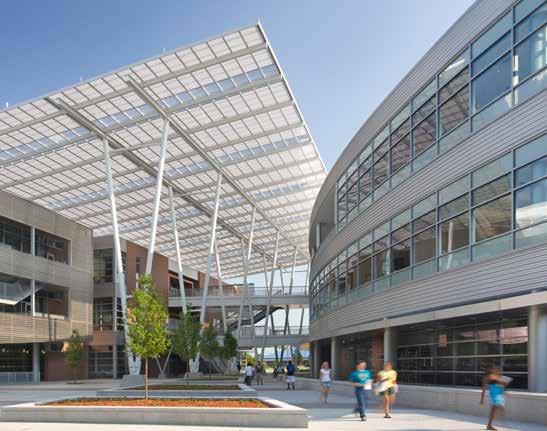
TRANSPORTATION HIGHWAYS
As the 12th-largest city in the United States Jacksonville benefits from an extensive transportation network that connects the vast 767 square miles of area the city covers. Located at the crossroads of Interstate-10 and Interstate-95, Jacksonville is accessible for drivers coming from any direction. Currently, the city is serviced by four interstate highways. Interstate-95, which runs north to south, and connects to Interstate-4 providing quick access to Orlando (140 miles southwest) and Miami (350 miles south). Interstate-10, which runs west to east, conveniently connects Jacksonville to Destin (300 miles west) and other gulf coast cities. Interstate-295 serves as a beltway routing around the city and connects to Interstate-10 and Interstate-95 while serving all areas of Jacksonville. Interstate-795 is a future expressway that will connect the southeastern section of Interstate-295 with Interstate-95.
JACKSONVILLE INTERNATIONAL AIRPORT
Jacksonville International Airport (JAX) was listed as one of the best airports in North America for service quality by the Airports Council International. The airport covers 7,911 acres and currently has two concrete runways. Future plans call for expanding the current concourses by 2020, expanding the parking system and adding a new automated baggage screening system. JAX provides non-stop flights to more than 30 major U.S. cities, and serves over 5 million passengers annually.
FIRST COAST COMMUTER RAIL
The First Coast Commuter Rail is a proposed commuter rail system serving the Jacksonville MSA. It is currently in the planning stages. Jacksonville Transportation Authority has identified three routes as primary candidates for the first phase of development. These routes would provide faster, easier access to various key locations in the Jacksonville MSA. Most significantly, the downtown-to-St. Augustine route would simplify public transportation to and from the ever-growing communities in St. Johns County. The concept is a natural fit for Jacksonville since the infrastructure is already largely in place because of the city’s status as a major railroad hub.

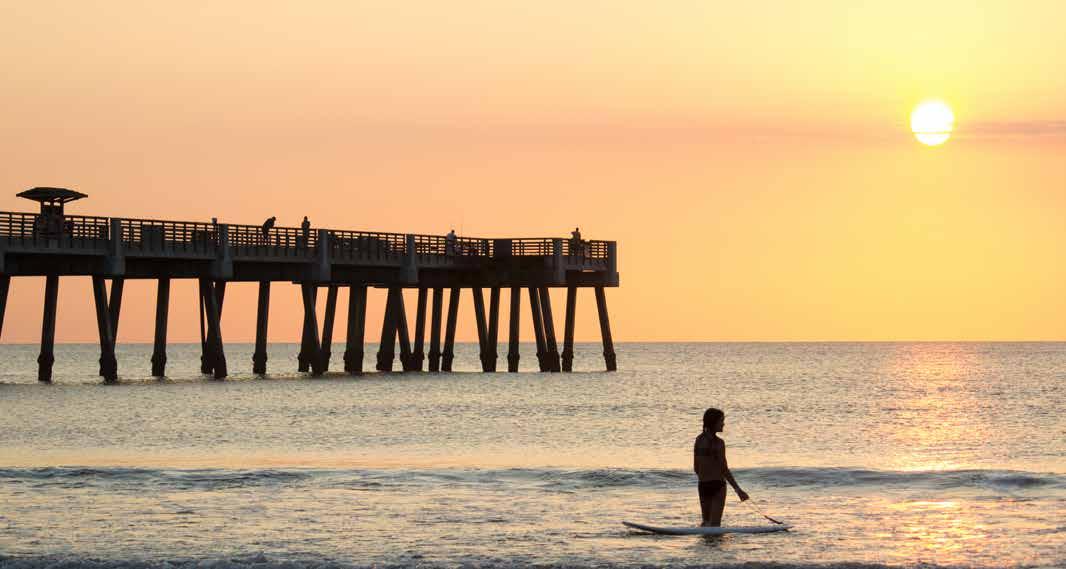
Jacksonville Beach Fishing Pier

Big Talbot Island State Park RECREATIONAL FACILITIES
The Jacksonville MSA offers a wide range of recreational alternatives for adults, teens and children. The City of Jacksonville operates the largest urban park system in the United States, providing services at more than 400 park and recreational sites consisting of a variety of parks, trails, athletic facilities, beaches, golf courses, aquatic facilities, nature preserves, along with an amphitheater, arboretum and an equestrian center. Due to Jacksonville’s sunny climate, recreation programs and activities are available year-round for park users of all ages and abilities. Below is a partial listing of some of Jacksonville’s most popular recreational facilities.
The Tournament Players Club at Sawgrass is home to the PGA Tour headquarters and The Players Championship golf tournament. The championship-caliber golf course was designed to improve the overall on-site fan experience at The Players Championship golf tournament, while also making it accessible to and playable by golf fans of all abilities.
The Jacksonville Beach Fishing Pier, nearly a quarter of a mile long, offers visitors close up views of the Atlantic Ocean and anglers access to deep-water species of fish. The Jacksonville Beach Fishing Pier offers a concession and bait shop, restrooms, and is wheel-chair accessible.
The Jacksonville Arboretum & Gardens is a 120-acre urban woodland that includes a stabilized walkway which encircles a beautiful two-acre lake and over three miles of rustic hiking trails that wind quietly through a series of distinct ecological habitats.
Big Talbot Island State Park is primarily a natural preserve providing a premier location for nature study, bird-watching and photography. The park consists of a boat/kayak launch, hiking and bicycle trails, picnic pavilions, and a unique beach that is famous for the salt-washed skeletons of live oak and cedar trees that once grew near the shore.
The Jacksonville Equestrian Center is an equestrian facility at the Cecil Commerce Center that consists of an indoor multi-purpose arena, two outdoor arenas, miles of trails, an Olympic size indoor pool with a community center and picnic pavilions.
CULTURAL ACTIVITIES
Jacksonville has grown into a world-class arts and culture destination. The local art and music scenes are alive with festivals and events. Below is a partial listing of some of Jacksonville’s most popular cultural activities.
The Jacksonville Jazz Festival is the second largest jazz festival in the United States. The festival began three decades ago and boasts an allstar lineup of jazz legends such as Miles Davis, Dizzy Gillespie, Brandford Marsalis and many more. The festival is held each Memorial Day weekend.
The Cummer Museum of Art and Gardens was founded in 1961 and holds one of the finest art collections in the Southeast, with nearly 5,000 objects in its Permanent Collection. The Museum offers world-class art spanning from 2100 B.C. through the 21st century, features diverse special exhibits and is home to the Wark Collection of Early Meissen Porcelain. The Museum’s 2.5 acres of historic gardens are unique examples of early 20th century garden design, featuring reflecting pools, fountains, arbors, antique ornaments and sculptures.
The Museum of Contemporary Art Jacksonville (MOCA) is located in the heart of downtown Jacksonville on historic Hemming Plaza. The museum displays the works of national and international artists of the 20th and 21st centuries. MOCA Jacksonville is one of the Southeast’s largest museums of modern and contemporary art.
The Jacksonville Symphony, founded in 1949, is one of the nation’s top regional orchestras and offers a variety of live symphonic music in the acoustically superb Jacoby Symphony Hall at the Times-Union Center for Performing Arts. Nearly 80,000 individuals annually experience the musician’s artistry through the Symphony’s comprehensive education and community engagement programs.
The Museum of Science & History (MOSH) is located on the Southbank Riverwalk and is the city’s most visited museum. It specializes in science and local history exhibits. It features a main exhibit that changes quarterly, three floors of permanent exhibits and the Bryan-Gooding Planetarium. ^ Exhibit at the Museum of Contemporary Art Jacksonville

The Jacksonville Symphony > Orchestra
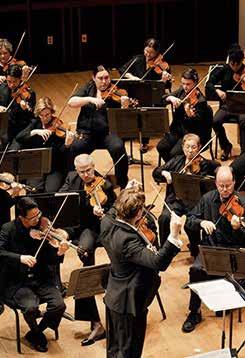
^ Dinosaur Exhibit at the Museum of Science & History Jacksonville


The Cummer Museum of > Art & Gardens
